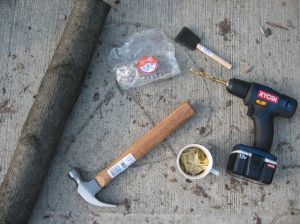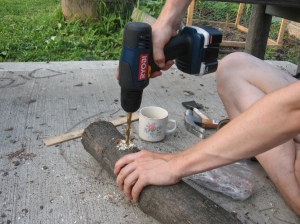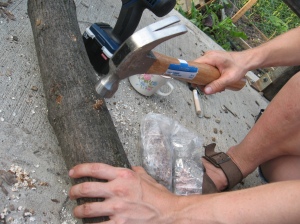Last week at the garden we went through the preliminary steps of adding a new crop to the garden – mushrooms! Shiitake mushrooms are grown on inoculated logs which can be left outside, making them better suited to our garden than other types of mushrooms, such as oyster, which is usually grown on sawdust or portabello, which needs complete darkness to grow. Shiitake mushrooms are ideal for our garden, because they require dappled light, little care, and are visually pleasing once they start to grow. Overall, it was a pretty easy process, provided you have all the right supplies on hand.
Here’s some further detail about each of the materials:
Log – this log should ideally be a hardwood; oak is the wood of choice for shiitake cultivation as it is the most durable wood available, lasting one year for each inch of diameter. Other woods, such as alder, poplar or maple (our choice) can be used as well. The log must be freshly-cut, and less than 3 months old so that there are still sugars present in the wood for the fungi to feed on. The log should be allowed to sit for at least 2 or 3 weeks so that the natural anti-fungal compounds the trees produce can be degraded. The logs should be at least 4 inches in diameter, and 3-4 feet long. Acquiring wood that meets all these criteria can pose a challenge, but the easiest way is to approach companies that cut urban trees, and request some boughs, ensuring the trees are not being cut due to disease. They will likely cut them for you, and provide them for free or a nominal charge.
Mushroom Spore Dowels – These are a mixture of mushroom spores and sawdust which are sold in packages of 100 for around $25. I purchased ours in Montreal, at the world’s only mushroom-only store Mycoboutique, but they can also be purchased in Ontario from Mycosource or Wylie Mycologicals.
Drill – Any drill with a 5/16 inch drill bit can be used
Wax and sponge brush – This is used to seal the holes after drilling to prevent colonization of the log by other pathogens. The wax used must be a food-grade wax such as beeswax or cheese wax. Beeswax can be found easily from honey vendors at farmers’ markets. The sponge brush is an excellent way to apply the wax gradually, but by the end the brush becomes too full of wax to be reused. It’s important that if you’re not doing the inoculation at
home, that there is a heatsource available for melting the wax. This was a problem for us at the garden, as we didn’t have a kitchen available, so I had to bring the logs home to seal them immediately after inserting the dowels. The wax must be melted above boiling water, if it is heated directly it won’t melt, and if heated long enough, can catch fire!
The process is relatively simple:
Step 1) holes are drilled 1 1/2 inches deep, six inches apart along the length of the logs and two inches apart around the diameter. Using a circular motion with the drill to widen the holes slightly beyond 5/16 inch made the process go much more smoothly.
Step 2) dowels are hammered into the holes until level with the bark surface.
Step 3) holes are sealed off with wax to prevent colonization of the log by bad bacteria or other fungi
Step 4) logs are stored upright in the garden in a shady spot, and kept watered and protected from winds. Then the waiting game begins! Unfortunately the logs will not fruit until the following summer, as it takes awhile for the fungi to fully colonize the wood. Once the cut ends of the logs turn black, you can tell that the wood is ready to fruit. After logs fruit once, they can be “forced” fruit again later in the season. This is done by shocking them: submerging them in ice cold water for 24-48 hours to create an artificial “winter”. One of the most interesting things I’ve read about forcing is that apparently, after shocking the logs, if you bang both ends of them with a hammer it speeds up the fruiting process. This is because it produces vibrations similar to a tree falling nearby, which sends the message to the mushrooms that they need to quickly reproduce to colonize this newly fallen food source! Pretty fascinating stuff.
Thanks to ontariowoodlot.com and fungi perfecti for providing excellent resources which I used to research my own mushroom log project.





